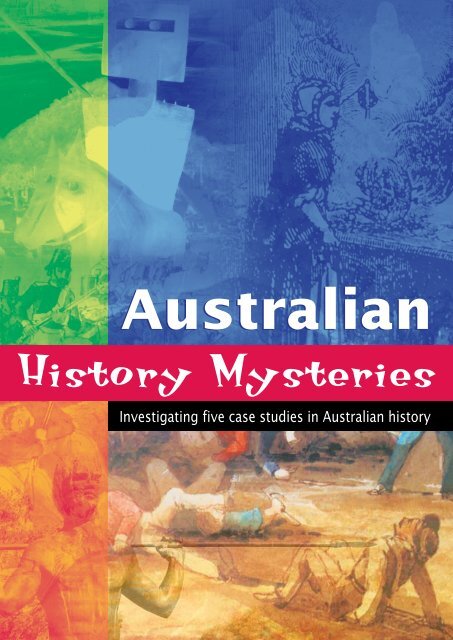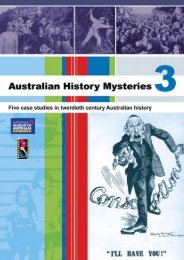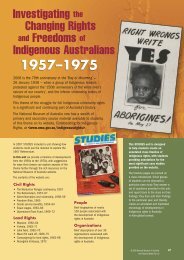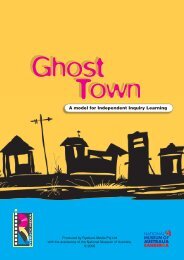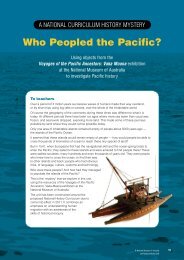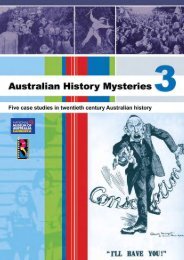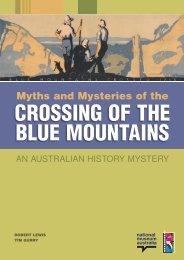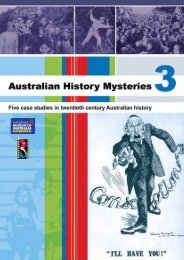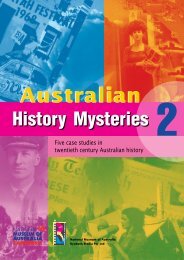Investigating five case studies in Australian history
Investigating five case studies in Australian history
Investigating five case studies in Australian history
Create successful ePaper yourself
Turn your PDF publications into a flip-book with our unique Google optimized e-Paper software.
<strong>Australian</strong><br />
History Mysteries<br />
<strong>Investigat<strong>in</strong>g</strong> <strong>five</strong> <strong>case</strong> <strong>studies</strong> <strong>in</strong> <strong>Australian</strong> <strong>history</strong>
ISBN 0-9493804-0-7<br />
© 2002 National Museum of Australia and Ryebuck Media Pty Ltd<br />
Written by Robert Lewis<br />
and Tim Gurry, Merrillee Chignell, Laura Griffiths, David Arnold<br />
Produced by<br />
National Museum of Australia<br />
Schools Program Section<br />
GPO Box 1901<br />
Canberra ACT 2601<br />
Phone (02) 6208 5119<br />
Fax (02) 6208 5198<br />
Email schools@nma.gov.au<br />
Website www.nma.gov.au<br />
Ryebuck Media Pty Ltd<br />
31 Station Street Malvern<br />
Victoria 3144<br />
Phone (03) 9500 2399<br />
Fax (03) 9500 2388<br />
Email ryebuck@ryebuck.com.au<br />
Website www.ryebuck.com.au<br />
Designed by Polar Design, Carlton, Victoria<br />
Pr<strong>in</strong>ted by Impact Pr<strong>in</strong>t<strong>in</strong>g, Brunswick, Victoria<br />
All efforts have been made to f<strong>in</strong>d copyright ownership of materials<br />
used <strong>in</strong> this publication. Any contraventions are accidental and will<br />
be redressed. For any copyright matters please contact Ryebuck<br />
Media Pty Ltd.<br />
Teachers are welcome to duplicate any pages <strong>in</strong> this publication for<br />
educational purposes <strong>in</strong> their classrooms.
Case Study <strong>five</strong><br />
Was Ned Kelly a hero<br />
or a villa<strong>in</strong>?<br />
On 11 November 1880 a 25- or 26-year-old man, Edward Kelly, was hanged <strong>in</strong> Melbourne<br />
for the murder of a policeman at Str<strong>in</strong>gybark Creek, <strong>in</strong> north-eastern Victoria.<br />
The headstone on the victim’s grave spoke of his murder by armed crim<strong>in</strong>als.<br />
At the same time there were people s<strong>in</strong>g<strong>in</strong>g bush ballads that praised Kelly as a hero.<br />
Which was he — hero, or murderer? And why has he become such a significant part of<br />
<strong>Australian</strong> national identity that he was presented to the world as one of Australia’s national<br />
icons at the 2000 Sydney Olympics open<strong>in</strong>g ceremony?<br />
These are some of the ideas explored <strong>in</strong> this <strong>case</strong> study. To do so, students need to be clear<br />
about the facts of Kelly’s life, and <strong>in</strong> particular the act for which he was hanged — the kill<strong>in</strong>g of<br />
Constable Lonigan (and other police) at Str<strong>in</strong>gybark Creek <strong>in</strong> 1878.<br />
Students <strong>in</strong>vestigate how different people can <strong>in</strong>terpret one set of facts very differently to come<br />
up with contrast<strong>in</strong>g ‘Ned as hero’ and ‘Ned as villa<strong>in</strong>’ <strong>in</strong>terpretations.<br />
They then put Kelly on trial for the event that set his fate — the kill<strong>in</strong>g of the three police at<br />
Str<strong>in</strong>gybark Creek <strong>in</strong> 1878. Was it cold-blooded murder? Was it an act of justifiable<br />
self-defence? Like the 1880 court, they focus on the death of Constable Lonigan, the only one<br />
of the three for which Kelly was tried.<br />
Students become witnesses, and have to present evidence and be challenged about it.<br />
At the end, students are better able to confront one of the icons of <strong>Australian</strong> <strong>history</strong>, and decide<br />
for themselves where they want to place that person <strong>in</strong> their own sense of their national identity.
Teachers’ Guide<br />
Classroom planner<br />
Classroom Resource Suggested Approximate<br />
activity pages required classroom format classroom time<br />
1 Page 104–105 Class 15 m<strong>in</strong>s<br />
2 Page 106 & video Class 15 m<strong>in</strong>s<br />
3 Page 107 Individual 15 m<strong>in</strong>s<br />
4 Pages 108–111 Group 40 m<strong>in</strong>s<br />
5 Pages 112–119 Groups/class 80 m<strong>in</strong>s<br />
6 Page 120 Individual/group 120 m<strong>in</strong>s<br />
There are more resources for this unit — read<strong>in</strong>g guides, updates,<br />
extra resources and activities for the classroom, <strong>in</strong>clud<strong>in</strong>g an <strong>in</strong>ternet<br />
‘game’ — at .<br />
Classroom strategies<br />
Activity 1 raises issues of what a hero is. Students should discuss their images, and fill <strong>in</strong> the<br />
‘hero’ and ‘villa<strong>in</strong>’ columns. Then ask them to complete a bra<strong>in</strong>storm about Ned Kelly. At the<br />
end students will be able to come back to this page and test their new knowledge, as well as<br />
th<strong>in</strong>k more deeply about how they will categorise Kelly.<br />
Activity 2 can be used to encourage students to survey parents about their knowledge of Ned<br />
Kelly — why has this person cont<strong>in</strong>ued to be known <strong>in</strong> our <strong>history</strong>? Teachers must make sure<br />
that students are clear what the ma<strong>in</strong> ‘mystery’ be<strong>in</strong>g explored is: Based on the kill<strong>in</strong>g of<br />
Constable Thomas Lonigan at Str<strong>in</strong>gybark Creek, was Ned Kelly a hero (the kill<strong>in</strong>g was<br />
justified) or a villa<strong>in</strong> (the kill<strong>in</strong>g was murder)?<br />
In Activity 3, students start to ga<strong>in</strong> <strong>in</strong>formation that will help their own <strong>in</strong>terpretation of Ned<br />
Kelly as villa<strong>in</strong> or hero.<br />
In Activity 4, students see how some writers have manipulated (and <strong>in</strong> some <strong>case</strong>s distorted)<br />
<strong>in</strong>formation to create effects. Work<strong>in</strong>g <strong>in</strong> groups, students have only one of the three accounts.<br />
They complete the summary table for that account. Students now form new groups so that<br />
there are ‘experts’ on each of the three accounts <strong>in</strong> each new group. All share their<br />
<strong>in</strong>formation, so that every person can complete the table for all three accounts. Discussion<br />
should br<strong>in</strong>g out the way <strong>in</strong> which each of the writers manipulates <strong>in</strong>formation to create<br />
an effect.<br />
Activity 5 is the key one <strong>in</strong> this unit. Students put Ned Kelly on trial for the kill<strong>in</strong>g of Thomas<br />
Lonigan at Str<strong>in</strong>gybark Creek <strong>in</strong> 1878. This is the crime that Kelly was tried for <strong>in</strong> 1880.<br />
102 <strong>Australian</strong> History Mysteries <strong>Investigat<strong>in</strong>g</strong> <strong>five</strong> <strong>case</strong> <strong>studies</strong> <strong>in</strong> <strong>Australian</strong> <strong>history</strong>
Each group is allocated two pieces of evidence from witnesses 1–6 (though all should have<br />
the evidence of witness 1, as this is Kelly’s own justification for what happened). Students<br />
should present one of their pieces of evidence as a statement that covers the four key issues<br />
as far as possible. Each group is also responsible for question<strong>in</strong>g a second witness. This can<br />
be organised thus:<br />
Group Presents Questions<br />
A 1 3<br />
B 2 6<br />
C 3 4<br />
D 4 5<br />
E 5 1<br />
F 6 2<br />
Other students can ask questions of the witness if someth<strong>in</strong>g is still unclear, or if there is a<br />
po<strong>in</strong>t that has not been made. Stress to witnesses that they can only provide <strong>in</strong>formation that<br />
is consistent with the document they are work<strong>in</strong>g from — they cannot ‘make up’ evidence <strong>in</strong><br />
the heat of the moment!<br />
Before they come to a conclusion, have students ‘test’ the consistency of the evidence given<br />
by McIntyre and Kelly. There are four versions of Kelly’s account of the shoot<strong>in</strong>g, and <strong>five</strong><br />
versions of McIntyre’s account, <strong>in</strong>cluded <strong>in</strong> this collection. Nom<strong>in</strong>ate four students to be Ned<br />
Kelly, and <strong>five</strong> to be McIntyre. Each has a particular version of the events — for Kelly,<br />
witnesses 1, 3, 4 and 5; for McIntyre, witnesses 2, 5, 6, 7 and 8. Each student must answer<br />
the same question, ‘Where was Lonigan when Kelly shot him?, read<strong>in</strong>g out only what the<br />
source they are us<strong>in</strong>g says about it. Students should underl<strong>in</strong>e the relevant statements, and<br />
read them verbatim to the class. This will clearly show any consistency or <strong>in</strong>consistency <strong>in</strong> the<br />
different versions. What does it mean when students discover that Kelly says the same th<strong>in</strong>g<br />
<strong>in</strong> all four different accounts, while McIntyre’s version differs <strong>in</strong> each of the <strong>five</strong> times he<br />
recorded it?<br />
A key fact to note here is that <strong>in</strong> reality Kelly did not present his defence at all. There were only<br />
prosecution witnesses, and his lawyer did not try to br<strong>in</strong>g out the ‘self-defence’ argument.<br />
Will students say that Kelly could be seen to be act<strong>in</strong>g <strong>in</strong> self-defence? Certa<strong>in</strong>ly his story is<br />
consistent at all times, but the issue of whether he had the chance to avoid kill<strong>in</strong>g, but chose<br />
to create the situation <strong>in</strong> which kill<strong>in</strong>g could occur by confront<strong>in</strong>g the police parties, can be<br />
raised. Can he really claim leniency for creat<strong>in</strong>g this situation? These are all issues that<br />
students will readily be able to discuss.<br />
F<strong>in</strong>ally, Activity 6 asks students to br<strong>in</strong>g together all their knowledge, and choose a<br />
comb<strong>in</strong>ation of objects that shows their own op<strong>in</strong>ion about Ned Kelly as hero and/or villa<strong>in</strong>.<br />
Case study 5 Was Ned Kelly a hero or a villa<strong>in</strong>?<br />
103
<strong>case</strong> study 5<br />
activity one<br />
What is a hero? What is a villa<strong>in</strong>?<br />
1 As a class, make a list of real people (liv<strong>in</strong>g or dead) who are your heroes.<br />
Briefly expla<strong>in</strong> <strong>in</strong> each <strong>case</strong> why they are your heroes.<br />
2 Do the same with any ‘villa<strong>in</strong>s’ that you are aware of.<br />
3 Out of this class discussion develop a set of characteristics or qualities that<br />
a hero or a villa<strong>in</strong> has. Use a table like this to help organise your criteria.<br />
At this stage, leave the ‘Ned Kelly’ column blank.<br />
Characteristics Hero Ned Kelly Villa<strong>in</strong><br />
Physical<br />
Character<br />
Actions,<br />
behaviour<br />
Qualities<br />
Attitudes<br />
to others<br />
Effect<br />
on others<br />
104 <strong>Australian</strong> History Mysteries <strong>Investigat<strong>in</strong>g</strong> <strong>five</strong> <strong>case</strong> <strong>studies</strong> <strong>in</strong> <strong>Australian</strong> <strong>history</strong>
<strong>case</strong> study 5<br />
activity one<br />
What is a hero? What is a villa<strong>in</strong>?<br />
Ned Kelly — hero or villa<strong>in</strong>?<br />
4 One man whom many people<br />
th<strong>in</strong>k is a hero is Ned Kelly.<br />
What do you know about him?<br />
Discuss this, and list up to 10<br />
th<strong>in</strong>gs you know about him.<br />
(Frearson’s Weekly, November 1878)<br />
(Australasian Sketcher, 3 July 1880)<br />
Case study 5 Was Ned Kelly a hero or a villa<strong>in</strong>?<br />
105
<strong>case</strong> study 5<br />
activity two<br />
Video visit<br />
Map of ‘Kelly country’<br />
1 Use this map to mark key<br />
places associated with<br />
Ned Kelly. Identify any<br />
places that you recognise<br />
and that are associated<br />
with Kelly (such as where<br />
he was born, where he<br />
robbed a bank, etc.).<br />
2 What is the image of<br />
Ned Kelly that emerges<br />
from the video?<br />
3 Expla<strong>in</strong> how this<br />
image seems to have<br />
been created <strong>in</strong> the<br />
video — through what is<br />
said, what is shown, the<br />
music used, and so on.<br />
(Jones, Ian, 1995. Ned Kelly. A Short Life, Lothian Books, Melbourne, p. xi)<br />
4 What is the mystery that<br />
you are be<strong>in</strong>g asked to<br />
<strong>in</strong>vestigate?<br />
106 <strong>Australian</strong> History Mysteries <strong>Investigat<strong>in</strong>g</strong> <strong>five</strong> <strong>case</strong> <strong>studies</strong> <strong>in</strong> <strong>Australian</strong> <strong>history</strong>
<strong>case</strong> study 5<br />
activity three<br />
Ned Kelly biography<br />
efore you decide on whether a person is a hero or a villa<strong>in</strong>, you need to know<br />
Bsome facts about their life. Here are some facts about the life of Ned Kelly.<br />
1854 Edward Kelly born at Beveridge <strong>in</strong> Victoria, the son of John<br />
or (‘Red’) and Ellen Kelly. His mother bore n<strong>in</strong>e children. His<br />
1855 eldest sister had died at birth, the next oldest <strong>in</strong> 1872, leav<strong>in</strong>g<br />
him as the oldest child.<br />
1865 Saved a boy from drown<strong>in</strong>g.<br />
1866 Red Kelly died, leav<strong>in</strong>g Ned the oldest male <strong>in</strong> the family.<br />
1869 Became an ‘apprentice’ or helper to bushranger<br />
Harry Power.<br />
Charged with assault and robbery. Dismissed.<br />
1870 Charged with robbery under arms (help<strong>in</strong>g Harry Power).<br />
Dismissed.<br />
Charged with assault, and obscene language — send<strong>in</strong>g an<br />
<strong>in</strong>decent letter to a woman (Kelly denied this). Three months’<br />
gaol.<br />
1871 Charged with illegally us<strong>in</strong>g a horse. Discharged.<br />
Charged with receiv<strong>in</strong>g a stolen horse (Kelly said he did not<br />
know it was stolen). Three years’ imprisonment. A policeman<br />
tried to shoot him dur<strong>in</strong>g the arrest. Kelly overpowered the<br />
policeman and humiliated him by pretend<strong>in</strong>g to ride him like a<br />
horse. The policeman later struck Kelly four or <strong>five</strong> times around<br />
the head with his revolver after he had been arrested.<br />
1874 Released from jail, and worked <strong>in</strong> various rural<br />
labour<strong>in</strong>g jobs.<br />
1877 Involved <strong>in</strong> an extensive cattle-steal<strong>in</strong>g and horse-steal<strong>in</strong>g<br />
bus<strong>in</strong>ess with his new father-<strong>in</strong>-law.<br />
Charged with drunkenness and assault<strong>in</strong>g police. F<strong>in</strong>ed.<br />
1878 Arrest warrant issued on Kelly for shoot<strong>in</strong>g Constable<br />
Fitzpatrick dur<strong>in</strong>g a visit to the Kelly farm. Fitzpatrick claimed<br />
he went there to arrest Dan Kelly, and Ned attacked him and<br />
shot him <strong>in</strong> the hand. Others there claimed Fitzpatrick was<br />
drunk, had tried to molest Ned’s sister, Kate, and was hit with<br />
a shovel by Ellen Kelly. Ned Kelly usually denied be<strong>in</strong>g<br />
<strong>in</strong>volved <strong>in</strong> this event (though sometimes his version of events<br />
changed and he agreed that he was there). Ned’s mother was<br />
sentenced to three years’ gaol for the assault, and two others<br />
to six years. Ned and Dan fled to the bush.<br />
With brother Dan, Joe Byrne and Steve Hart, Kelly killed three<br />
police at Str<strong>in</strong>gybark Creek.<br />
Armed robbery of Euroa National Bank.<br />
1879 Armed robbery of Jerilderie Bank.<br />
1880 Shoot-out at Glenrowan after an attempt to derail a police<br />
tra<strong>in</strong>. A school teacher, Thomas Curnow, freed by the Kellys<br />
so he could attend to his sick sister, warned the tra<strong>in</strong> just<br />
before it reached the wrecked section of rails. Kelly was<br />
wounded, and disappeared for several hours. He returned to<br />
shoot it out with the police. Once the hostages were out of the<br />
build<strong>in</strong>g (though some had been killed or wounded <strong>in</strong> the<br />
cross-fire dur<strong>in</strong>g the siege), police burnt down the build<strong>in</strong>g.<br />
Joe Byrne had been killed early <strong>in</strong> the siege, and Dan Kelly<br />
and Steve Hart probably committed suicide. Kelly was<br />
captured.<br />
Ned Kelly tried before Justice Redmond Barry for the murder<br />
of Constable Lonigan at Str<strong>in</strong>gybark Creek <strong>in</strong> 1878, found<br />
guilty, and hanged on 11 November.<br />
(Based on <strong>in</strong>formation <strong>in</strong> McMenomy, Keith, 2001. Ned Kelly.<br />
The Authentic Illustrated History, Hardie Grant Publish<strong>in</strong>g, Melbourne.)<br />
1 Which of these <strong>in</strong>cidents might you stress if<br />
you were try<strong>in</strong>g to make Kelly out to be a<br />
villa<strong>in</strong>? Colour them <strong>in</strong> a particular colour, or<br />
create a symbol to go with each.<br />
2 Which would you stress if you were try<strong>in</strong>g to<br />
make him out to be a hero? Colour them <strong>in</strong> a<br />
different colour, or create a different symbol<br />
to go with each.<br />
(McMenomy, Keith, 2001. Ned Kelly. The Authentic Illustrated<br />
History, Hardie Grant Publish<strong>in</strong>g, Melbourne, p. 81)<br />
Case study 5 Was Ned Kelly a hero or a villa<strong>in</strong>?<br />
107
<strong>case</strong> study 5<br />
activity four<br />
Different representations of Ned Kelly<br />
There are three short biographical descriptions, or representations, of Kelly on the follow<strong>in</strong>g<br />
pages. (A representation is simply the way someone chooses to depict a person or an event.)<br />
They all draw on similar <strong>in</strong>formation to that you have just looked at.<br />
Complete a summary based on one account <strong>in</strong> a table like the one below. Work with other students<br />
to add the <strong>in</strong>formation from the other two accounts. Then answer the questions that follow.<br />
Aspect Account 1 Account 2 Account 3<br />
Appearance<br />
Family<br />
Crim<strong>in</strong>al acts<br />
Character<br />
or qualities<br />
Motivation<br />
for behaviour<br />
Discuss these questions:<br />
1 What details are given <strong>in</strong> all three accounts?<br />
2 There are differences of fact <strong>in</strong> some of the accounts. How would<br />
you decide which version is accurate where there are differences?<br />
3 What key elements are selected and what are omitted?<br />
4 Why do writers make these choices and leave gaps?<br />
5 What is emphasised <strong>in</strong> each?<br />
6 What mean<strong>in</strong>gs or <strong>in</strong>terpretations are offered?<br />
7 Compare the tone of each of the three accounts. Which is neutral,<br />
which is pro-Kelly, and which is more critical of him?<br />
8 Which do you th<strong>in</strong>k is the best account? Why?<br />
9 Writers have basically the same <strong>in</strong>formation to work with when<br />
they write about Ned Kelly. Why do you th<strong>in</strong>k people can produce<br />
such different versions?<br />
108 <strong>Australian</strong> History Mysteries <strong>Investigat<strong>in</strong>g</strong> <strong>five</strong> <strong>case</strong> <strong>studies</strong> <strong>in</strong> <strong>Australian</strong> <strong>history</strong>
<strong>case</strong> study 5<br />
activity four<br />
Representation 1<br />
In the Wombat Ranges they were jo<strong>in</strong>ed by two other men<br />
… Joe Byrne (aged 21) and Steve Hart (aged 19). Ned<br />
Kelly was 24 and Dan was 17.<br />
In October 1878 four policemen were sent to hunt for the Kelly<br />
Gang. They met at Str<strong>in</strong>gybark Creek and Ned shot three of<br />
them dead.<br />
In December 1878 the Kellys held up the bank at Euroa and<br />
escaped with £2000.<br />
In February 1879 the Kellys rode <strong>in</strong>to Jerilderie, locked up two<br />
policemen, dressed <strong>in</strong> their uniforms and robbed the bank.<br />
In June 1880 Joe Byrne shot<br />
Aaron Sherritt who had once<br />
been his friend but had s<strong>in</strong>ce<br />
become a police spy.<br />
Next day, on June 27, the gang<br />
took over the town of<br />
Glenrowan.<br />
They held sixty people <strong>in</strong> the<br />
hotel and ripped up the railway<br />
l<strong>in</strong>e so that the police tra<strong>in</strong><br />
would be derailed. For hours<br />
they ate, drank and sang, then<br />
they made a mistake.<br />
They let a school teacher,<br />
Thomas Curnow, leave the hotel<br />
to take his sick wife and sister<br />
home. Curnow waved down the<br />
tra<strong>in</strong> and told the police what<br />
had happened.<br />
The last battle began.<br />
The police surrounded the hotel.<br />
Wear<strong>in</strong>g armour made from<br />
plough metal, Ned was hit <strong>in</strong> the<br />
legs and f<strong>in</strong>ally collapsed. Police<br />
set fire to the hotel. Joe Byrne<br />
was shot and the bodies of<br />
Steve Hart and Dan Kelly were<br />
badly burned.<br />
Ned Kelly was taken to<br />
Melbourne and tried for murder<br />
<strong>in</strong> October 1880. He was<br />
sentenced to death and hanged<br />
on 11 November 1880.<br />
(‘The Life and Death of Ned Kelly’, <strong>in</strong> Coupe,<br />
Sheena, Coupe, Robert and Andrews, Mary,<br />
1994. Their Ghosts May Be Heard, Pearson<br />
Education Australia, Melbourne, pp. 239–241)<br />
Case study 5 Was Ned Kelly a hero or a villa<strong>in</strong>?<br />
109
<strong>case</strong> study 5<br />
activity four<br />
Representation 2<br />
Kelly, Edward (‘Ned’) (1855–80).<br />
Bushranger whose career and<br />
execution cont<strong>in</strong>ues to excite<br />
controversy.<br />
Kelly was born to Irish rural poor:<br />
his father was an ex-convict from<br />
Tas. and his mother’s family were<br />
subject to constant police<br />
attention.<br />
In 1871–74, after several m<strong>in</strong>or<br />
offences, Kelly was imprisoned<br />
for horse-steal<strong>in</strong>g. In mid-1878<br />
he and his brother Dan fled to<br />
the bush after a policeman falsely<br />
accused them of shoot<strong>in</strong>g and<br />
wound<strong>in</strong>g him. Two other young<br />
men, Joe Byrne and Steve Hart,<br />
jo<strong>in</strong>ed them.<br />
In Oct. they shot dead three<br />
troopers sent to apprehend them.<br />
On 9 Dec. they raided a bank at<br />
Euroa (Vic.) and <strong>in</strong> Feb. 1879<br />
captured the town of Jerilderie<br />
(N.S.W.). For the next sixteen<br />
months they hid <strong>in</strong> the Strathbogie<br />
Ranges <strong>in</strong> northern Vic.<br />
In June 1880 they provoked a<br />
confrontation with police when<br />
Joe Byrne shot dead Aaron<br />
Sherritt, a known <strong>in</strong>former, on his<br />
selection near Beechworth. The<br />
gang assembled at Glenrowan,<br />
conf<strong>in</strong>ed most of the<br />
townspeople <strong>in</strong> a hotel, then<br />
removed railway l<strong>in</strong>es, <strong>in</strong>tend<strong>in</strong>g<br />
to derail a police tra<strong>in</strong> and<br />
ambush the occupants. However,<br />
the police were forewarned by a<br />
hostage who had been permitted<br />
to leave the hotel.<br />
At first the gang engaged the<br />
police from the front of the hotel,<br />
believ<strong>in</strong>g that their makeshift<br />
armour would protect them. Kelly<br />
was wounded three times and<br />
crawled <strong>in</strong>to nearby scrub where<br />
he lost consciousness; the others<br />
retreated to the hotel where<br />
Byrne was fatally wounded as he<br />
stood dr<strong>in</strong>k<strong>in</strong>g. Kelly re-entered<br />
the battle and was shot down<br />
and captured. Inside the hotel a<br />
man and a boy were killed by<br />
police bullets and, after the<br />
surviv<strong>in</strong>g hostages were<br />
permitted to leave, it was set<br />
alight. Later the charred bodies<br />
of Hart and Dan Kelly, who had<br />
apparently poisoned themselves,<br />
were found <strong>in</strong>side.<br />
In Oct. Ned Kelly was found guilty<br />
of murder before Sir Redmond<br />
Barry and executed on<br />
11 Nov., despite a petition for<br />
mercy signed by 60 000 people.<br />
While officialdom cont<strong>in</strong>ues to<br />
consider him a common crim<strong>in</strong>al,<br />
he has been regarded by many<br />
people as a symbol of the post<br />
gold-rush rural poor.<br />
(Lark<strong>in</strong>s, J. (ed.), 1980. Dictionary of <strong>Australian</strong><br />
History, Rigby, Adelaide, pp. 130–1)<br />
110 <strong>Australian</strong> History Mysteries <strong>Investigat<strong>in</strong>g</strong> <strong>five</strong> <strong>case</strong> <strong>studies</strong> <strong>in</strong> <strong>Australian</strong> <strong>history</strong>
<strong>case</strong> study 5<br />
activity four<br />
Representation 3<br />
Kelly, Edward ‘Ned’ (1855–80),<br />
bushranger, has lived two lives.<br />
One Ned Kelly was hanged <strong>in</strong><br />
Melbourne on 11 November<br />
1880, aged 25. The other lives,<br />
and began supplant<strong>in</strong>g the first<br />
even before he died. Two<br />
photographs show these Kellys.<br />
One, taken <strong>in</strong> 1874 from slightly<br />
above, is of Ned unshaven, with<br />
th<strong>in</strong> mouth, narrow eyes, and the<br />
p<strong>in</strong>ch of poverty. It shows a man<br />
at the mercy of his enemies. The<br />
other, taken the day before he<br />
died from slightly below, is of<br />
Ned bearded, strong, and<br />
resolute. It shows a young<br />
statesman.<br />
The man hanged was probably<br />
born <strong>in</strong> January 1855, eldest son<br />
of John and Ellen Kelly, née<br />
Qu<strong>in</strong>n, at Beveridge, Victoria. In<br />
1866 his father died and the<br />
family moved to a hut near Greta<br />
<strong>in</strong> north-eastern Victoria. Ned ran<br />
with the Greta larrik<strong>in</strong>s, and was<br />
first arrested aged 14, for<br />
assault<strong>in</strong>g a Ch<strong>in</strong>ese. He spent<br />
more time <strong>in</strong> prison than as a<br />
bushranger: eight months <strong>in</strong><br />
1870; three years <strong>in</strong> 1871–74;<br />
four months <strong>in</strong> 1880.<br />
In April 1878 a policeman<br />
attempt<strong>in</strong>g to arrest Ned’s<br />
brother Dan (1861-80) was<br />
wounded at the Kelly home;<br />
Ellen was gaoled for three years<br />
and two Kelly associates for six.<br />
With warrants aga<strong>in</strong>st them, Ned<br />
and Dan holed up <strong>in</strong> the Wombat<br />
Ranges with Joe Byrne and<br />
Steve Hart. At Str<strong>in</strong>gybark Creek<br />
on 26 October this gang<br />
ambushed and killed three of<br />
four police hunt<strong>in</strong>g them. That<br />
December they took to<br />
bushrang<strong>in</strong>g, robb<strong>in</strong>g a<br />
homestead and a Euroa bank,<br />
and <strong>in</strong> February 1879 bail<strong>in</strong>g up<br />
Jerilderie, NSW. On 26 June<br />
(Kelly and Horse, Sidney Nolan (1946) Nolan Gallery, Lanyon, Canberra)<br />
1880 they murdered a police<br />
<strong>in</strong>former, Aaron Sherritt, which<br />
led them to a police shoot-out at<br />
Glenrowan two days later. The<br />
others died: Ned escaped but,<br />
clad <strong>in</strong> his ploughshare armour,<br />
returned and was captured for<br />
execution.<br />
Bushranger is an <strong>Australian</strong><br />
word. It evokes bushcraft, dar<strong>in</strong>g,<br />
defiance, and freedom from<br />
convention, rather than crime or<br />
evil … Ned fits the model only <strong>in</strong><br />
part. His offences were few. He<br />
was only a fair bushman and<br />
horseman: he knew the ranges<br />
better than the police, that was<br />
all, and when that advantage<br />
was threatened by Queensland<br />
trackers he was led to folly at<br />
Glenrowan …<br />
Ned’s legend came to life<br />
because he offered more than<br />
bushrang<strong>in</strong>g. His love of ‘Kelly<br />
country’ … let him be <strong>Australian</strong>;<br />
his courage and strength spoke<br />
for the frontier. Aged 16 he<br />
straddled and spurred a<br />
policeman <strong>in</strong> Greta’s ma<strong>in</strong> street;<br />
aged 19 he beat Wild Wright<br />
bare-knuckle over 20 rounds.<br />
After Str<strong>in</strong>gybark Creek his<br />
actions took on a sense of<br />
dest<strong>in</strong>y, reveal<strong>in</strong>g allegiance to<br />
two traditions about <strong>in</strong>justice: the<br />
defiance of the Lachlan men,<br />
and the wrongs of Ireland. In<br />
bail<strong>in</strong>g up Jerilderie and<br />
Glenrowan he imitated<br />
[bushranger Ben] Hall; <strong>in</strong> his<br />
dar<strong>in</strong>g and fatalism he chose<br />
both a short and merry life, and<br />
martyrdom. His Jerilderie Letter<br />
evokes resistance more than<br />
crime: it protests at <strong>in</strong>justice and<br />
h<strong>in</strong>ts at a republic <strong>in</strong> north-east<br />
Victoria …<br />
(Extracts from entry on Ned Kelly by Bill<br />
Gammage <strong>in</strong> Graeme Davison, John Hirst and<br />
Stuart Mac<strong>in</strong>tyre (eds), 2001. Oxford<br />
Dictionary of <strong>Australian</strong> History, Oxford<br />
University Press, Melbourne, Revised edition,<br />
pp. 365–6)<br />
Case study 5 Was Ned Kelly a hero or a villa<strong>in</strong>?<br />
111
<strong>case</strong> study 5<br />
activity <strong>five</strong><br />
Putt<strong>in</strong>g Ned Kelly on trial<br />
t is time to try to settle the question about Ned Kelly as hero or villa<strong>in</strong> by look<strong>in</strong>g at<br />
one of the most important moments <strong>in</strong> Ned Kelly’s life, the event that was the cause<br />
Iof his be<strong>in</strong>g hanged <strong>in</strong> 1880 — the events at Str<strong>in</strong>gybark Creek <strong>in</strong> 1878.<br />
Sergeant<br />
Kennedy<br />
Constable<br />
Scanlon<br />
Constable<br />
Lonigan<br />
Constable<br />
McIntyre<br />
The event<br />
The charge<br />
The law<br />
Prosecution task<br />
Defence task<br />
Ned Kelly, Dan Kelly, Steve Hart and Joe Byrne were camped near<br />
Str<strong>in</strong>gybark Creek. Ned claimed that they believed that there were<br />
several police patrols search<strong>in</strong>g for them, to arrest Ned for the<br />
shoot<strong>in</strong>g of Constable Fitzpatrick. They believed that the group at<br />
Str<strong>in</strong>gybark Creek was one of these patrols. The police were heavily<br />
armed, and disguised as gold prospectors.<br />
The Kellys took the police by surprise, and killed three of them. One<br />
policeman, Constable McIntyre, escaped. After this <strong>in</strong>cident the gang<br />
was hunted cont<strong>in</strong>uously for the next two years. They robbed banks at<br />
Euroa and Jerilderie, and killed Aaron Sheritt, a suspected police<br />
<strong>in</strong>former and once best friend of Joe Byrne. At Glenrowan they were<br />
plann<strong>in</strong>g an extraord<strong>in</strong>ary event, because they had manufactured four<br />
sets of armour to protect them. They tried to wreck a police tra<strong>in</strong>, but<br />
eventually freed their hostages, and were all killed except Ned, who<br />
was seriously wounded, captured, and put on trial.<br />
This is the po<strong>in</strong>t <strong>in</strong> Kelly’s life that we are now up to — you are<br />
about to put Kelly on trial.<br />
The charge is that Kelly murdered Constable Thomas Lonigan at<br />
Str<strong>in</strong>gybark Creek. Kelly could have been charged with any and all of<br />
the three deaths, but was prosecuted only for one. Lonigan’s death<br />
was chosen because McIntyre saw most of what happened, and could<br />
give direct, eye-witness evidence. He did not see Kennedy’s death as<br />
clearly, and did not see Scanlan’s death at all.<br />
The law at the time was that a kill<strong>in</strong>g could be murder, or a lesser<br />
crime of manslaughter. Murder was kill<strong>in</strong>g someone with <strong>in</strong>tention,<br />
without good cause. The kill<strong>in</strong>g might not be murder if it was done<br />
accidentally, or justifiably — such as <strong>in</strong> self-defence, when that was<br />
what a person needed to do, or really believed they needed to do, to<br />
protect themselves. In this <strong>case</strong> it might be manslaughter, or no crime<br />
at all.<br />
The prosecution tries to prove that it was murder; the defence does not<br />
have to prove anyth<strong>in</strong>g, only raise doubt that the events happened <strong>in</strong><br />
the way the prosecution says. In effect, though, the defence usually<br />
tries to prove that it was less than deliberate kill<strong>in</strong>g. You will have to<br />
make your own decision based on the evidence.<br />
Ned Kelly<br />
Joe Byrne<br />
Dan Kelly<br />
Steve Hart<br />
112 <strong>Australian</strong> History Mysteries <strong>Investigat<strong>in</strong>g</strong> <strong>five</strong> <strong>case</strong> <strong>studies</strong> <strong>in</strong> <strong>Australian</strong> <strong>history</strong>
<strong>case</strong> study 5<br />
activity <strong>five</strong><br />
Putt<strong>in</strong>g Ned Kelly on trial<br />
Witnesses<br />
Present<strong>in</strong>g<br />
evidence<br />
There are three ma<strong>in</strong> k<strong>in</strong>ds of witnesses:<br />
• two eye-witnesses to the events (Kelly and McIntyre)<br />
• several people who heard Kelly talk about the events<br />
• the medical report by the doctor who exam<strong>in</strong>ed Lonigan’s body.<br />
Each group will be responsible for ‘becom<strong>in</strong>g’ one of the witnesses, and giv<strong>in</strong>g that witness’<br />
account to the class. You will also be ‘cross-exam<strong>in</strong>ed’ (questioned) about your evidence.<br />
When you give your evidence you need to clearly cover as many of these <strong>five</strong> aspects as<br />
you can from the evidence you have:<br />
• Who are you and how do you know what you know (as an eye-witness or hav<strong>in</strong>g heard<br />
Kelly speak about the events)?<br />
• Who killed Lonigan?<br />
• Was it deliberate or accidental?<br />
• Was there any motivation for the kill<strong>in</strong>g?<br />
• Was there any justification for it?<br />
(McQuilton, John, 1979. The Kelly Outbreak, Melbourne University Press, Melbourne, between pages 66 and 67)<br />
Use this table to keep a record of the evidence of the witnesses.<br />
Witness Who did Circumstances Attitude of Kelly Any<br />
the shoot<strong>in</strong>g? of the shoot<strong>in</strong>g? at the time? justification<br />
1<br />
2<br />
3<br />
4<br />
5<br />
6<br />
Once you have heard and discussed all the evidence, make your decision:<br />
was Ned Kelly guilty or not guilty of murder accord<strong>in</strong>g to the law at the time.<br />
Case study 5 Was Ned Kelly a hero or a villa<strong>in</strong>?<br />
113
<strong>case</strong> study 5<br />
activity <strong>five</strong><br />
Putt<strong>in</strong>g Ned Kelly on trial<br />
Reconstruction of the shoot<strong>in</strong>g of Constable Lonigan at Str<strong>in</strong>gybark Creek<br />
(On this sketch identify:<br />
• the Kelly gang<br />
• Constable McIntyre<br />
• Constable Lonigan)<br />
(Jones, Ian, 1995. Ned Kelly. A Short Life, Lothian Books,<br />
Melbourne, between pages 148 and 149)<br />
114 <strong>Australian</strong> History Mysteries <strong>Investigat<strong>in</strong>g</strong> <strong>five</strong> <strong>case</strong> <strong>studies</strong> <strong>in</strong> <strong>Australian</strong> <strong>history</strong>
<strong>case</strong> study 5<br />
activity <strong>five</strong><br />
Putt<strong>in</strong>g Ned Kelly on trial<br />
Witness 1<br />
Ned Kelly, <strong>in</strong> the Jerilderie Letter, 1879<br />
“<br />
I heard I was outlawed and a hundred pound reward for me for shoot<strong>in</strong>g a trooper <strong>in</strong> Victoria …<br />
heard how the police used to be blow<strong>in</strong>g that they would not ask me to stand they would shoot me first and<br />
then cry surrender and how they used to rush <strong>in</strong>to the house upset all the milk dishes break t<strong>in</strong>s of eggs<br />
empty the flour out of bags onto the ground and even the meat out of the cask and destroy all the<br />
provisions and shove the girls <strong>in</strong> front of them <strong>in</strong>to the rooms like dogs so as if anyone was there they<br />
would shoot the girls first but they knew well I was not there or I would have scattered their blood and<br />
bra<strong>in</strong>s like ra<strong>in</strong> I would manure the Eleven Mile with their bloated carcasses and yet remember there is not<br />
one drop of murderous blood <strong>in</strong> my ve<strong>in</strong>s …<br />
this sort of cruelty and disgraceful and cowardly conduct to my brothers and sisters who had no protection<br />
coupled with the conviction of my mother … certa<strong>in</strong>ly made my blood boil and I don’t th<strong>in</strong>k there is a<br />
man born could have the patience to suffer it as long as I did or ever allow his blood to get cold while such<br />
<strong>in</strong>sults as these were unavenged…<br />
[at Str<strong>in</strong>gybark Creek] me and my brother went and found their camp … We saw they carried long<br />
firearms and we knew our doom was sealed if we could not beat those before the others would come as I<br />
knew the other party of Police would soon jo<strong>in</strong> them and if they came on us at our camp they would shoot<br />
us down like dogs at our work as we only had two guns we thought it best to try and bail those up, take<br />
their firearms and ammunition and horses and we could stand a chance with the rest…<br />
McIntyre laid his gun aga<strong>in</strong>st a stump and Lonigan sat on the log I advanced … but when I called on<br />
them to throw up their hands McIntyre obeyed and Lonigan ran some six or seven yards to a battery of<br />
logs <strong>in</strong>stead of dropp<strong>in</strong>g beh<strong>in</strong>d the one he was sitt<strong>in</strong>g on, he had just got to the logs and put his head up to<br />
take aim when I shot him that <strong>in</strong>stant or he would of shot me …<br />
Lonigan [was] the man who <strong>in</strong> company with Sergeant Whelan Fitzpatrick and K<strong>in</strong>g the Bootmaker and<br />
Constable O’Day that tried to put a pair of handcuffs on me <strong>in</strong> Benalla but could not … who caught me<br />
by the privates and would have sent me to K<strong>in</strong>gdom come … and he is the man that blowed before he left<br />
Violet Town if Ned Kelly was to be shot he was the man who would shoot him and no doubt he would<br />
shoot me even if I threw up my arms and laid down as he knew four of them could not arrest me s<strong>in</strong>gle<br />
handed … As soon as I shot Lonigan he jumped up and staggered some distance from the logs with his<br />
hands raised and then fell he surrendered but too late …<br />
I asked McIntyre … I expect your gang came to do the same with me he said no they did not come to<br />
shoot me they came to apprehend me I asked him what they carried spencer rifles and breech load<strong>in</strong>g<br />
fowl<strong>in</strong>g pieces and so much ammunition for as the Police was only supposed to carry one revolver and 6<br />
cartridges <strong>in</strong> the revolver, but they had eighteen rounds of revolver cartridges and three dozen for each of<br />
the fowl<strong>in</strong>g piece and twenty one spencer rifle cartridges and God knows how many they had away with<br />
the rifle this looked as if they meant not only to shoot me but to riddle me … this cannot be called wilful<br />
murder for I was compelled to shoot them, or lie down and let them shoot me … certa<strong>in</strong>ly their wives and<br />
children are to be pitied but they must remember those men came <strong>in</strong>to the bush with the <strong>in</strong>tention of<br />
scatter<strong>in</strong>g pieces of me and my brother all over the bush.<br />
“<br />
To read the whole of the Jerilderie Letter go to<br />
<br />
What do you learn about Kelly, the man, from that letter? Consider such th<strong>in</strong>gs as language,<br />
behaviour, emotions, humour, attitudes, background or family events, etc.<br />
Case study 5 Was Ned Kelly a hero or a villa<strong>in</strong>?<br />
115
<strong>case</strong> study 5<br />
activity <strong>five</strong><br />
Putt<strong>in</strong>g Ned Kelly on trial<br />
Witness 2<br />
Police Constable Thomas McIntyre,<br />
evidence given <strong>in</strong> October 1880<br />
“[McIntyre and Lonigan were camped, while Scanlon and Kennedy were out search<strong>in</strong>g for<br />
signs of the Kellys] I had the tea made & Lonigan was stand<strong>in</strong>g on the opposite side of the fire. I<br />
was stand<strong>in</strong>g close to the fire at the time. I suddenly heard some voices cry<strong>in</strong>g out — Bail up! Hold<br />
up your hands!<br />
I quickly turned round and saw four men each armed with a gun, hav<strong>in</strong>g a gun at his shoulder<br />
po<strong>in</strong>t<strong>in</strong>g to Lonigan and myself, I noticed the man on the right of the party particularly. I saw that<br />
his weapon was fair l<strong>in</strong>e with my chest.<br />
I immediately put out my arms horizontally I was unarmed — so soon as I did, I saw the same<br />
man, the one on the right of the party, move his gun a little to his own right, and fire at Lonigan<br />
who had started to run. When I first saw the men, Lonigan was stand<strong>in</strong>g at the opposite side of the<br />
fire to me and about 10 or 12 feet from me, Lonigan had started to run. . . towards a tree . . .<br />
The effect of the shot <strong>in</strong> Lonigan was that he immediately fell — He ran only about four or <strong>five</strong><br />
yards before he fell, I heard him fall I did not see him fall . . . The man at the right of the four men<br />
was the prisoner Edward Kelly . . .<br />
About this time I heard Lonigan cease to struggle and breath — He had been struggl<strong>in</strong>g and<br />
plung<strong>in</strong>g along the ground . . . From the time he was shot till he ceased to struggle about half a<br />
m<strong>in</strong>ute elapsed all he said was Oh Christ I am shot!<br />
He [Kelly] next jumped across the log and went <strong>in</strong> the direction where Lonigan was ly<strong>in</strong>g . . .<br />
Prisoner rema<strong>in</strong>ed away a moment, & came back with Lonigans revolver <strong>in</strong> his hand. I was under<br />
cover of the other three all this time. prisoner said when he came back Dear oh! Dear! What a pity<br />
that man tried to get away, one of the others said. He was a plucky fellow — Did you see how he<br />
caught at his revolver — and the man who spoke was the prisoner’s brother (Dan Kelly) moved his<br />
right hand spasmodically to his right side and said — I like that! . . .<br />
Prisoner said “who is that over there?” and nodded <strong>in</strong> the direction of Lonigans body. I said “that is<br />
Lonigan” He said “no that is not Lonigan. I know Lonigan well” I said<br />
“Oh yes it is Lonigan” he said “well I am glad of that — for the<br />
Bugger gave me a hid<strong>in</strong>g <strong>in</strong> Benalla one day”<br />
Prisoners Brother remarked that “he would lock no more poor<br />
buggers up” — and smiled at the time he said it.<br />
<br />
“<br />
(J. Sadlier, Recollections<br />
of a Victorian Police Officer)<br />
116 <strong>Australian</strong> History Mysteries <strong>Investigat<strong>in</strong>g</strong> <strong>five</strong> <strong>case</strong> <strong>studies</strong> <strong>in</strong> <strong>Australian</strong> <strong>history</strong>
<strong>case</strong> study 5<br />
activity <strong>five</strong><br />
Putt<strong>in</strong>g Ned Kelly on trial<br />
Witness 3<br />
James Gloster, hawker of<br />
drapery goods, who was held<br />
prisoner for several hours dur<strong>in</strong>g<br />
the robbery of a bank at Euroa<br />
Witness 4<br />
George Stephans, groom, who<br />
was held prisoner for several<br />
hours dur<strong>in</strong>g the robbery of a<br />
bank at Eurora<br />
“[Kelly] said ‘The people & papers call me<br />
a murderer but I never murdered any one <strong>in</strong> my<br />
life’ I said ‘How about Sergeant Kennedy’ He<br />
said ‘I killed him <strong>in</strong> Fair fight’ ‘Fair stand up<br />
fight’ He argued then that a man kill<strong>in</strong>g his<br />
enemy was not murder — He said ‘the police are<br />
my natural enemies’<br />
In another conversation addressed to some one<br />
else which I overheard the accused described the<br />
death of Lonigan. He said McIntyre surrendered<br />
but Lonigan ran to a log and was attempt<strong>in</strong>g to<br />
fire when he (the accused) fired & hit Lonigan <strong>in</strong><br />
the head kill<strong>in</strong>g him — He said it was a pity that<br />
Lonigan did not surrender that he did not wish to<br />
kill Lonigan but only to take their arms.<br />
“<br />
“<br />
I was stand<strong>in</strong>g talk<strong>in</strong>g to the prisoner …<br />
I said ‘How about the police murders?’<br />
He said we were beh<strong>in</strong>d a log — I told Dan to<br />
cover Lonigan — & I would cover the other man,<br />
I then called out, Throw up your hands, He said<br />
‘McIntyre did so and Lonigan made off for the<br />
logs try<strong>in</strong>g to draw his revolver as he did so.’ He<br />
said he (Lonigan) got down beh<strong>in</strong>d the logs and<br />
rested his revolver on the top of the log, He said I<br />
then took my rifle off McIntyre and fired at<br />
Lonigan — He said that the ball grazed him<br />
along the temple & he (Lonigan) disappeared<br />
beh<strong>in</strong>d the log. He gradually then rose his hands<br />
up above the logs — and when his hand appeared<br />
I fired aga<strong>in</strong> and shot him through the head<br />
“<br />
<br />
(Illustrated Sydney News, November 1880)<br />
Case study 5 Was Ned Kelly a hero or a villa<strong>in</strong>?<br />
117
<strong>case</strong> study 5<br />
activity <strong>five</strong><br />
Putt<strong>in</strong>g Ned Kelly on trial<br />
Witness 5<br />
John Kelly, poice officer,<br />
who had played a part <strong>in</strong><br />
the hunt for the Kelly gang<br />
“<br />
I met Constable<br />
McIntyre we went <strong>in</strong>to the<br />
Lock up where Kelly was<br />
… McIntyre said ‘Why did<br />
you come near us when you<br />
knew where we were’<br />
He said ‘You would have<br />
soon found me out & ye<br />
would have shot me’ he<br />
cont<strong>in</strong>ued ‘our horses were<br />
very poor we had bad arms<br />
we had no money & we<br />
wanted to make a rise’<br />
McIntyre said ‘You had the<br />
rifle presented to my chest<br />
and you immediately<br />
turned around and fired at<br />
Lonigan when I had my<br />
hands up’<br />
Prisoner said ‘no Lonigan<br />
was beh<strong>in</strong>d a log and was<br />
po<strong>in</strong>t<strong>in</strong>g his revolver at me<br />
when I shot him’<br />
McIntyre said ‘that's all<br />
nonsense He had not his<br />
revolver po<strong>in</strong>ted at you’<br />
“<br />
The site of the Str<strong>in</strong>gybark Creek kill<strong>in</strong>gs<br />
(Victoria Police Historical Unit)<br />
Dr Samuel Reynolds, who exam<strong>in</strong>ed Lonigan’s<br />
Witness 6 body after the shoot<strong>in</strong>g at Str<strong>in</strong>gybark Creek<br />
“<br />
I am a legally qualified medical practitioner and surgeon<br />
resid<strong>in</strong>g at Mansfield … I had first seen the body of Lonigan at<br />
Str<strong>in</strong>g Bark creek early on the Monday morn<strong>in</strong>g of the 28th Oct<br />
— the day before I made the postmortem exam<strong>in</strong>ation — I first<br />
saw the body ly<strong>in</strong>g <strong>in</strong> its position on the back … I noticed a wound<br />
<strong>in</strong> the face on Lonigans body — I made the postmortem<br />
exam<strong>in</strong>ation on the body of Lonigan on the follow<strong>in</strong>g day at<br />
Mansfield — On exam<strong>in</strong><strong>in</strong>g the body I found four wounds — one<br />
through the left arm and one on the left thigh, and one on the right<br />
temple, and one to the <strong>in</strong>ner side of the right eye-ball, from the<br />
appearance of these wounds I looked upon them as bullet wounds<br />
— The wound on the left arm was simply a hole through the arm<br />
The one on the thigh — the bullet had travelled under the sk<strong>in</strong> &<br />
round the thigh — nearly to the <strong>in</strong>ner side of the thigh The wound<br />
on the right temple I might describe as a graze — The one on the<br />
<strong>in</strong>ner side of the right eyeball, I traced through the bones <strong>in</strong>to the<br />
bra<strong>in</strong> & followed the wound <strong>in</strong>to the bra<strong>in</strong>, and was satisfied as to<br />
the cause of death a few seconds would elapse before death from<br />
such a wound.<br />
“<br />
<br />
118 <strong>Australian</strong> History Mysteries <strong>Investigat<strong>in</strong>g</strong> <strong>five</strong> <strong>case</strong> <strong>studies</strong> <strong>in</strong> <strong>Australian</strong> <strong>history</strong>
<strong>case</strong> study 5<br />
activity <strong>five</strong><br />
Putt<strong>in</strong>g Ned Kelly on trial<br />
Additional evidence<br />
Other statements made by McIntyre<br />
Statement made by McIntyre<br />
Witness 7 the day after the shoot<strong>in</strong>gs<br />
“<br />
About 5 p.m. I be<strong>in</strong>g Cook for the day<br />
was <strong>in</strong> the act of mak<strong>in</strong>g some tea, Const.<br />
Lonigan stand<strong>in</strong>g beside me, Suddenly and<br />
without us be<strong>in</strong>g aware of their approach four<br />
men with rifles presented at us called upon us<br />
to 'bail up hold up your hands.' I be<strong>in</strong>g<br />
disarmed at the time did so. Constable<br />
Lonigan made a motion to draw his revolver<br />
which he was carry<strong>in</strong>g. immediately he did so<br />
he was shot by Edward Kelly and I believe<br />
died immediately.<br />
“<br />
Statement made by McIntyre<br />
soon after escap<strong>in</strong>g from<br />
Witness 8 Str<strong>in</strong>gybark creek<br />
“<br />
About <strong>five</strong> o’clock on the afternoon of<br />
Saturday, while I was at the fire cook<strong>in</strong>g our<br />
food for the even<strong>in</strong>g meal, suddenly Lonigan<br />
and I heard the call to throw up our hands,<br />
and saw four armed men, partly concealed by<br />
the timber, cover<strong>in</strong>g us with their guns . . . I<br />
threw up my hands. Lonigan was sitt<strong>in</strong>g on a<br />
log, and on hear<strong>in</strong>g the call to throw up his<br />
hands, he put his hands to his revolver, at the<br />
same time slipp<strong>in</strong>g down for cover beh<strong>in</strong>d the<br />
log on which he had been sitt<strong>in</strong>g. Lonigan had<br />
his head above the level of the log and was<br />
about to use his revolver when he was shot<br />
through the head.<br />
“<br />
<br />
(Illustrated Sydney News, November 1880)<br />
Case study 5 Was Ned Kelly a hero or a villa<strong>in</strong>?<br />
119
<strong>case</strong> study 5<br />
activity six<br />
Reflection<br />
1 Go back to the third column <strong>in</strong> Activity 1<br />
(page 104), and fill <strong>in</strong> any <strong>in</strong>formation you<br />
now have about Ned Kelly. Do you now<br />
consider Ned Kelly to be a hero or a<br />
villa<strong>in</strong>? Expla<strong>in</strong> why.<br />
2 There have been many bushrangers <strong>in</strong><br />
<strong>Australian</strong> <strong>history</strong>, but few are still<br />
remembered today. Why do you th<strong>in</strong>k Kelly<br />
is seen as such an important part (or an<br />
‘icon’) of <strong>Australian</strong> <strong>history</strong> and identity?<br />
Why do you th<strong>in</strong>k he has been and<br />
cont<strong>in</strong>ues to be remembered? Discuss the<br />
possible reasons.<br />
Ned Kelly — villa<strong>in</strong> or hero exhibition<br />
3 Create a museum display, poster or<br />
PowerPo<strong>in</strong>t presentation about the life of<br />
Ned Kelly. Draw<strong>in</strong>g from your knowledge of<br />
him, and imag<strong>in</strong><strong>in</strong>g that you could <strong>in</strong>clude<br />
anyth<strong>in</strong>g you like, list:<br />
• some evidence that might show him as<br />
a ‘hero’ (for example, you might show his<br />
armour, and say that it shows him as a<br />
hero ready to face extreme odds)<br />
• some evidence that might show him as<br />
a ‘villa<strong>in</strong>’ (for example, you might <strong>in</strong>clude<br />
a length of railway l<strong>in</strong>e, and say that this<br />
showed he was ready to slaughter the<br />
police who were com<strong>in</strong>g to arrest him).<br />
Choose at least six of these objects and<br />
pieces of evidence that will show what you<br />
have now come to believe about Ned Kelly.<br />
Describe or show the items, and write an<br />
explanatory caption for each.<br />
Further research<br />
4 You have touched on many aspects of the<br />
Kelly story <strong>in</strong> this <strong>case</strong> study, but there are<br />
many aspects of it that need far more<br />
detail. Work<strong>in</strong>g <strong>in</strong> groups, research these<br />
aspects of his life. Then create a class<br />
Kelly biography for presentation to the<br />
library. Aspects to cover might <strong>in</strong>clude:<br />
• early life<br />
• work<strong>in</strong>g with Harry Power<br />
• his family<br />
• ‘go<strong>in</strong>g straight’<br />
• the Fitzpatrick <strong>in</strong>cident<br />
• the kill<strong>in</strong>gs at Str<strong>in</strong>gybark Creek<br />
• the Euroa bank robbery<br />
• the Jerilderie bank robbery<br />
• the kill<strong>in</strong>g of Aaron Sherritt<br />
• siege at Glenrowan<br />
• trial and execution<br />
• the Kelly image.<br />
Alternatively, research some of the ballads<br />
that have been written about the Kellys.<br />
Create your own ballad about the gang.<br />
(Robert Lewis) (Robert Lewis) (Australasian Sketcher, 20 November 1880)<br />
120 <strong>Australian</strong> History Mysteries <strong>Investigat<strong>in</strong>g</strong> <strong>five</strong> <strong>case</strong> <strong>studies</strong> <strong>in</strong> <strong>Australian</strong> <strong>history</strong>
<strong>Australian</strong><br />
History Mysteries<br />
<strong>Investigat<strong>in</strong>g</strong> <strong>five</strong> <strong>case</strong> <strong>studies</strong> <strong>in</strong> <strong>Australian</strong> <strong>history</strong><br />
Ryebuck Media Pty Ltd<br />
National Museum of Australia


